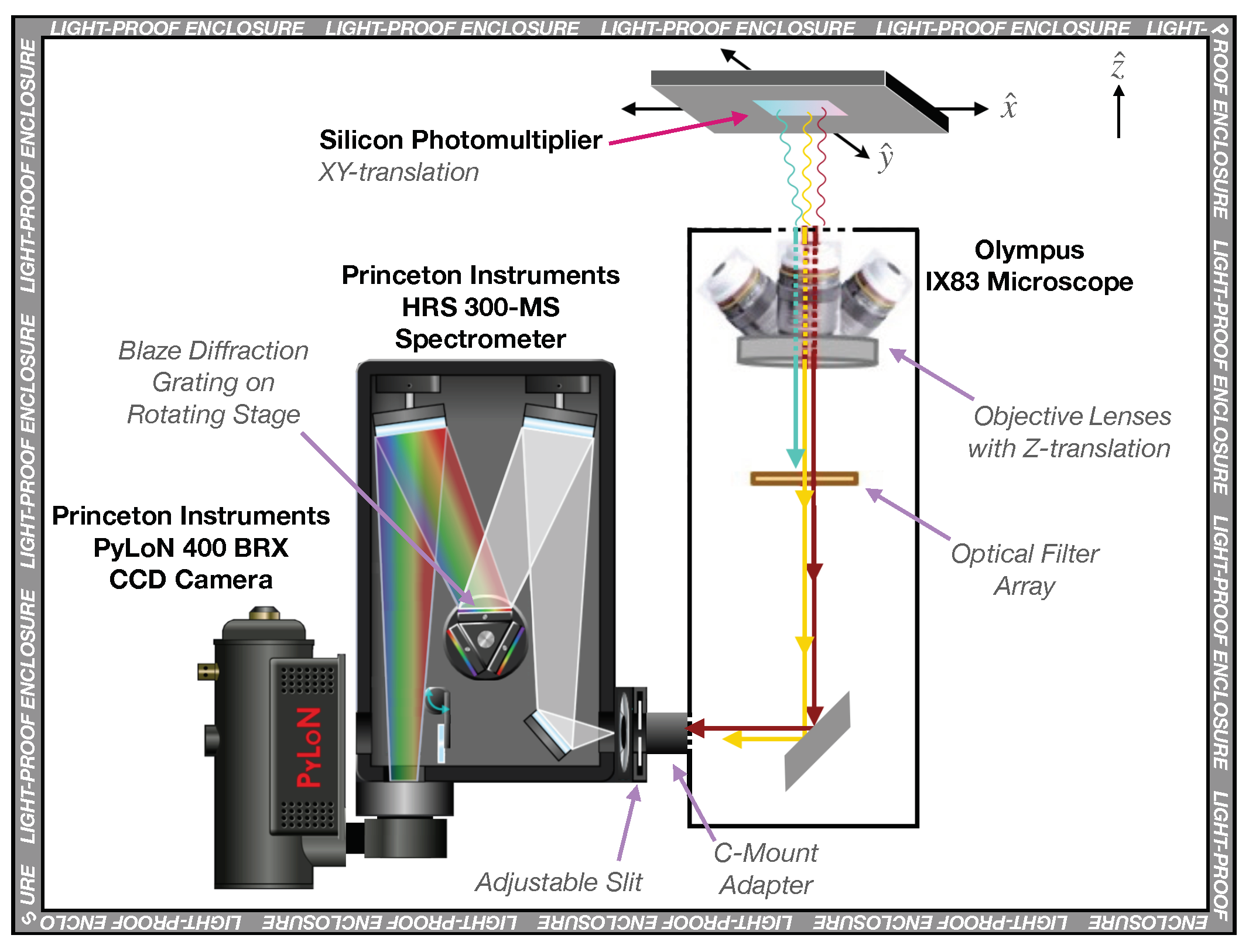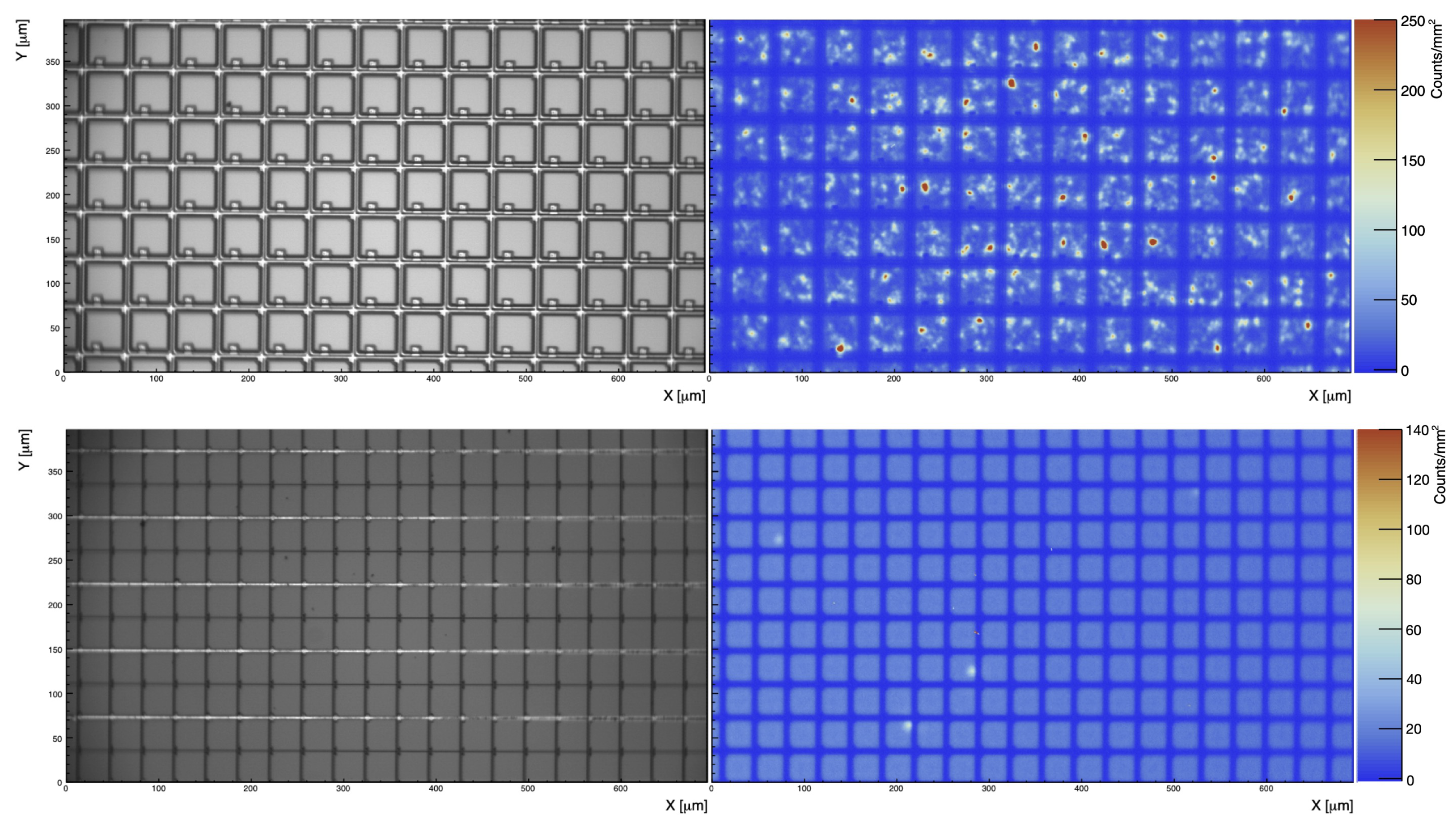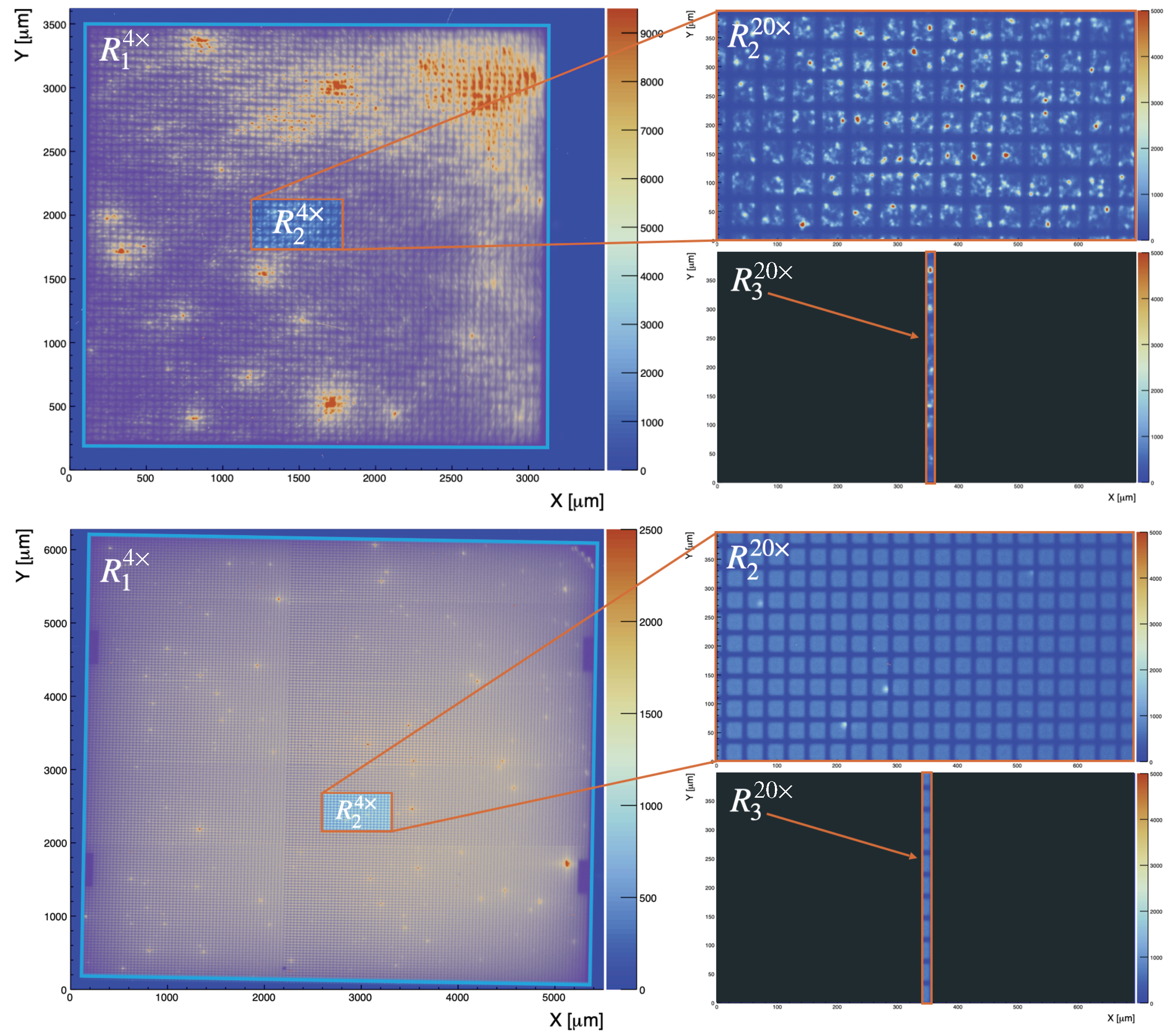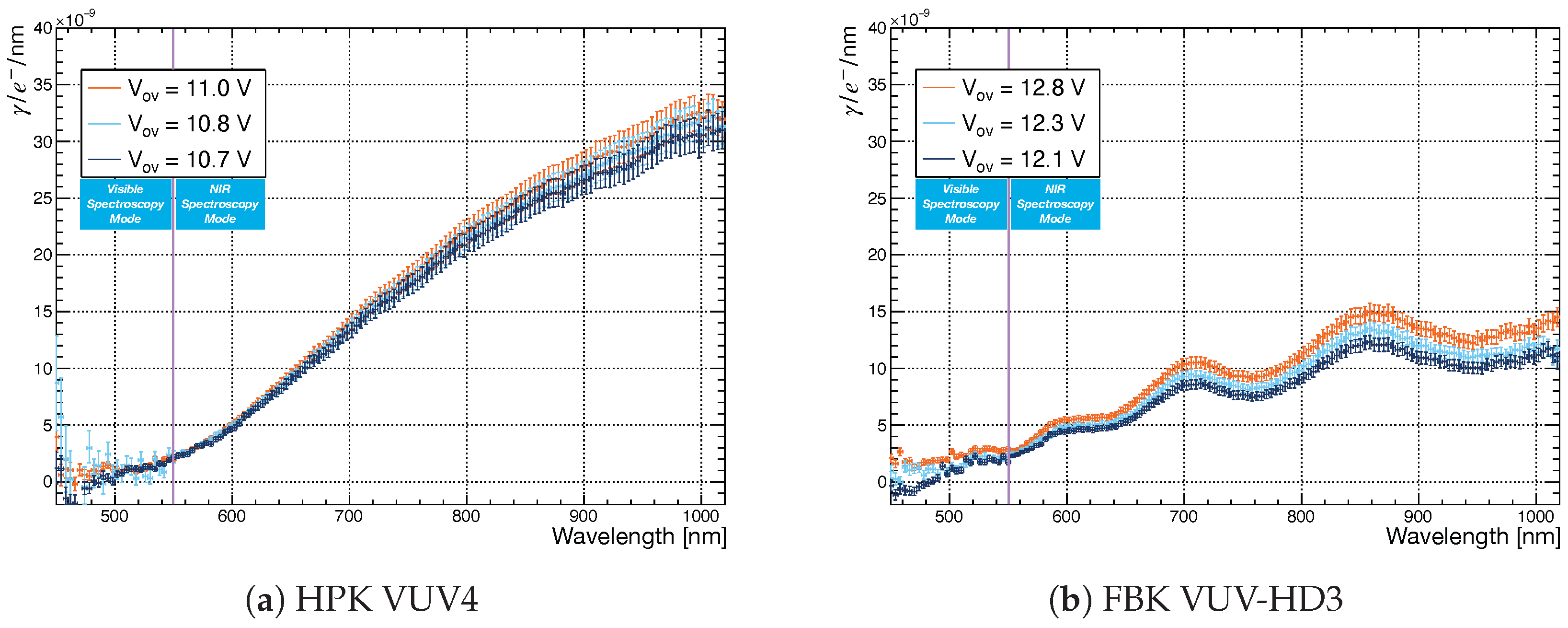Characterisation of SiPM Photon Emission in the Dark
Abstract
1. Introduction
2. Triumf Characterization Setup
- 1.
- Imaging mode
- 2.
- Spectroscopy mode
- (i)
- A Hg and Ne-Ar line source for wavelength calibration with emission lines between 200 nm and 1000 nm.
- (ii)
- A NIST traceable LED based light source for relative intensity calibration in the range 450–1020 nm
3. Imaging of the Biased Sipm
4. Spectroscopy of the Biased Sipm
4.1. Evaluation of the Correction Factor
4.2. Evaluation of the Correction Factor
4.3. Evaluation of the SiPM Photon Yields
5. Conclusions
Author Contributions
Funding
Acknowledgments
Conflicts of Interest
References
- Baudis, L.; Galloway, M.; Kish, A.; Marentini, C.; Wulf, J. Characterisation of Silicon Photomultipliers for liquid xenon detectors. J. Instrum. 2018, 13, P10022. [Google Scholar] [CrossRef]
- Capasso, M.; Acerbi, F.; Borghi, G.; Ficorella, A.; Furlan, N.; Mazzi, A.; Merzi, S.; Mozharov, V.; Regazzoni, V.; Zorzi, N.; et al. FBK VUV-sensitive Silicon Photomultipliers for cryogenic temperatures. Nucl. Instrum. Methods Phys. Res. Sect. A 2020, 982, 164478. [Google Scholar] [CrossRef]
- Falcone, A.; Andreani, A.; Bertolucci, S.; Brizzolari, C.; Buckanam, N.; Capasso, M.; Cattadori, C.; Carniti, P.; Citterio, M.; Francis, K.; et al. Cryogenic SiPM arrays for the DUNE photon detection system. Nucl. Instrum. Methods Phys. Res. Sect. A 2021, 985, 164648. [Google Scholar] [CrossRef]
- Carnesecchi, F. Light detection in DarkSide-20k. J. Instrum. 2020, 15, C03038. [Google Scholar] [CrossRef]
- Aalseth, C.E.; Acerbi, F.; Agnes, P.; Albuquerque, I.F.M.; Alexander, T.; Alici, A.; Alton, A.K.; Antonioli, P.; Arcelli, S.; Ardito, R.; et al. DarkSide-20k: A 20 tonne two-phase LAr TPC for direct dark matter detection at LNGS. Eur. Phys. J. Plus 2018, 133, 131. [Google Scholar] [CrossRef]
- Gallina, G.; Giampa, P.; Retière, F.; Kroeger, J.; Zhang, G.; Ward, M.; Margetak, P.; Li, G.; Tsang, T.; Doria, L.; et al. Characterization of the Hamamatsu VUV4 MPPCs for nEXO. Nucl. Instrum. Methods Phys. Res. Sect. A 2019, 940, 371–379. [Google Scholar] [CrossRef]
- Acerbi, F.; Ferri, A.; Zappala’, G.; Paternoster, G.; Picciotto, A.; Gola, A.; Zorzi, N.; Piemonte, C. NUV Silicon Photomultipliers With High Detection Efficiency and Reduced Delayed Correlated-Noise. IEEE Trans. Nucl. Sci. 2015, 62, 1318–1325. [Google Scholar] [CrossRef]
- Newman, R. Visible Light from a Silicon p − n Junction. Phys. Rev. 1955, 100, 700–703. [Google Scholar] [CrossRef]
- Rosado, J.; Aranda, V.; Blanco, F.; Arqueros, F. Modeling crosstalk and afterpulsing in silicon photomultipliers. Nucl. Instrum. Methods Phys. Res. Sect. A 2015, 787, 153–156. [Google Scholar] [CrossRef]
- Nepomuk Otte, A. On the efficiency of photon emission during electrical breakdown in silicon. Nucl. Instrum. Methods Phys. Res. Sect. A 2009, 610, 105–109. [Google Scholar] [CrossRef]
- Sun, H.; Zhang, Z.; Ogudo, K.A.; Xu, K.; Snyman, L.S. Light emission from Si avalanche mode LEDs as a function of E field control, impurity scattering, and carrier density balancing. In Proceedings of the Fifth Conference on Sensors, MEMS, and Electro-Optic Systems, Skukuza, South Africa, 8–10 October 2019; Volume 11043, p. 1104307. [Google Scholar]
- Liu, L.; Zhang, C.; Gallina, G.; Zhang, G. 2D microspatial distribution uniformity of photon detection efficiency and crosstalk probability of multi-pixel photon counters. Quantum Electron. 2020, 50, 197–200. [Google Scholar] [CrossRef]
- Akil, N.; Kerns, S.; Kerns, D.; Hoffmann, A.; Charles, J.-P. A multimechanism model for photon generation by silicon junctions in avalanche breakdown. IEEE Trans. Electron Devices 1999, 46, 1022–1028. [Google Scholar] [CrossRef]
- Gautam, D.; Khokle, W.; Garg, K. Photon emission from reverse-biased silicon PN junctions. Solid-State Electron. 1988, 31, 219–222. [Google Scholar] [CrossRef]
- Lacaita, A.L.; Zappa, F.; Bigliardi, S.; Manfredi, M. On the bremsstrahlung origin of hot-carrier-induced photons in silicon devices. IEEE Trans. Electron Devices 1993, 40, 577–582. [Google Scholar] [CrossRef]
- Gundacker, S.; Heering, A. The silicon photomultiplier: Fundamentals and applications of a modern solid-state photon detector. Phys. Med. Biol. 2020, 65, 17TR01. [Google Scholar] [CrossRef]
- Retière, F.; Boone, K. Delayed avalanches in Multi-Pixel Photon Counters. J. Instrum. 2017, 12, P07026. [Google Scholar] [CrossRef][Green Version]
- Gallina, G. Development of a Single Vacuum Ultra-Violet Photon-Sensing Solution for nEXO. Ph.D. Thesis, University of British Columbia, Vancouver, BC, Canada, 2021. [Google Scholar] [CrossRef]
- Otte, A.N.; Garcia, D.; Nguyen, T.; Purushotham, D. Characterization of three high efficiency and blue sensitive silicon photomultipliers. Nucl. Instrum. Methods Phys. Res. Sect. A Accel. Spectrom. Detect. Assoc. Equip. 2017, 846, 106–125. [Google Scholar] [CrossRef]
- Jamil, A.; Ziegler, T.; Hufschmidt, P.; Li, G.; Lupin-Jimenez, L.; Michel, T.; Ostrovskiy, I.; Retiere, F.; Schneider, J.; Wagenpfeil, M.; et al. VUV-Sensitive Silicon Photomultipliers for Xenon Scintillation Light Detection in nEXO. IEEE Trans. Nucl. Sci. 2018, 65, 2823–2833. [Google Scholar] [CrossRef]
- Acerbi, F.; Davini, S.; Ferri, A.; Galbiati, C.; Giovanetti, G.; Gola, A.; Korga, G.; Mandarano, A.; Marcante, M.; Paternoster, G.; et al. Cryogenic Characterization of FBK HD Near-UV Sensitive SiPMs. IEEE Trans. Electron Devices 2017, 64, 521–526. [Google Scholar] [CrossRef]
- Engelmann, E.; Popova, E.; Vinogradov, S. Spatially resolved dark count rate of SiPMs. Eur. Phys. J. C 2018, 78, 1–8. [Google Scholar] [CrossRef]
- Nagai, A.; Alispach, C.; Barbano, A.; Coco, V.; della Volpe, D.; Heller, M.; Montaruli, T.; Ekoume, S.N.; Troyano-Pujadas, I.; Renier, Y. Characterisation of a large area silicon photomultiplier. arXiv 2018, arXiv:1810.02275. [Google Scholar]
- Mirzoyan, R.; Kosyra, R.; Moser, H.-G. Light emission in Si avalanches. Nucl. Instrum. Methods Phys. Res. Sect. A 2009, 610, 98–100. [Google Scholar] [CrossRef]
- Kittel, C. Introduction to Solid State Physics; Wiley: New York, NY, USA, 1986; Volume 6. [Google Scholar]
- McClure, J.; Gooding, E. IntelliCal: A Novel Method For Calibration Of Imaging Spectrographs. AIP Conf. Proc. 2010, 1267, 806–807. [Google Scholar]
- Jackson, J.C.; Hurley, P.K.; Lane, B.; Mathewson, A.; Morrison, A.P. Comparing leakage currents and dark count rates in Geiger-mode avalanche photodiodes. Appl. Phys. Lett. 2002, 80, 4100–4102. [Google Scholar] [CrossRef][Green Version]
- Instrument, P. PyLoN System User Manual. 2007. Available online: https://www.princetoninstruments.com/wp-content/uploads/2020/04/PyLoN-System-Manual-Issue-5-4411-0136.pdf (accessed on 30 August 2021).
- Lv, P.; Cao, G.F.; Wen, L.J.; Al Kharusi, S.; Anton, G.; Arnquist, I.J.; Badhrees, I.; Barbeau, P.S.; Beck, D.; Belov, V.; et al. Reflectance of Silicon Photomultipliers at Vacuum Ultraviolet Wavelengths. IEEE Trans. Nucl. Sci. 2020, 67, 2501–2510. [Google Scholar] [CrossRef]
- Griffiths, D.J. Introduction to Electrodynamics; Prentice Hall: Hoboken, NJ, USA, 1962. [Google Scholar]
- Martin, A.G. Self-consistent optical parameters of intrinsic silicon at 300 K including temperature coefficients. Sol. Energy Mater. Sol. Cells 2008, 92, 1305–1310. [Google Scholar] [CrossRef]
- Gallina, G.; Retiere, F.; Giampa, P.; Kroeger, J.; Margetak, P.; Mamahit, S.B.; Croix, A.D.S.; Edaltafar, F.; Martin, L.; Massacret, N.; et al. Characterization of SiPM Avalanche Triggering Probabilities. IEEE Trans. Electron Devices 2019, 66, 4228–4234. [Google Scholar] [CrossRef]
- Aspnes, D.E.; Studna, A. Dielectric functions and optical parameters of si, ge, gap, gaas, gasb, inp, inas, and insb from 1.5 to 6.0 ev. Phys. Rev. B 1983, 27, 985. [Google Scholar] [CrossRef]
- Rodríguez-De Marcos, L.V.; Larruquert, J.I.; Méndez, J.A.; Aznárez, J.A. Self-consistent optical constants of SiO2 and Ta2O5 films. Opt. Mater. Express 2016, 6, 3622–3637. [Google Scholar] [CrossRef]
- Wolff, P. Theory of optical radiation from breakdown avalanches in germanium. J. Phys. Chem. Solids 1960, 16, 184–190. [Google Scholar] [CrossRef]
- Haecker, W. Infrared radiation from breakdown plasmas in Si, GaSb, and Ge: Evidence for direct free hole radiation. Phys. Status Solidi 1974, 25, 301–310. [Google Scholar] [CrossRef]
- Piemonte, C.; Acerbi, F.; Ferri, A.; Gola, A.; Paternoster, G.; Regazzoni, V.; Zappala’, G.; Zorzi, N. Performance of NUV-HD Silicon Photomultiplier Technology. IEEE Trans. Electron Devices 2016, 63, 1111–1116. [Google Scholar] [CrossRef]








| Parameter | FBK VUV-HD3 | HPK VUV4 |
|---|---|---|
| Total Area | 6 × 6 mm | 3 × 3 mm |
| SiPM Fill Factor | 80% | 60% |
| SPAD pitch | m | m |
| Breakdown Voltage [298 K] | 31 ± 1 V | 52 ± 1 V |
| Lens Model | Magnification | Numerical Aperture | Primary Use |
|---|---|---|---|
| PLCN4X-1-7 | 4× | 0.1 | Imaging |
| LMPLFLN20X | 20× | 0.4 | Visible Spectroscopy |
| LCPLN20XIR | 20× | 0.45 | NIR Spectroscopy |
| Exposure Time | FBK VUV-HD3 | HPK VUV4 | |||
|---|---|---|---|---|---|
| Visible | NIR | Visible | NIR | ||
| [V] | 12.1 ± 1.0 | 12.1 ± 1.0 | 10.7 ± 1.0 | 10.7 ± 1.0 | |
| 8 h 20 min | [μA] | 59.1 ± 1.2 | 66.2 ± 1.3 | 78.8 ± 0.6 | 33.3 ± 0.3 |
| [C] | 1.77 ± 0.12 | 1.99 ± 0.12 | 2.36 ± 0.12 | 1.00 ± 0.12 | |
| [V] | 12.4 ± 1.0 | 12.4 ± 1.0 | 10.8 ± 1.0 | 10.8 ± 1.0 | |
| 4 h 45 min | [μA] | 87.1 ± 0.6 | 97.5 ± 1.0 | 46.4 ± 0.4 | 88.0 ± 0.6 |
| [C] | 1.49 ± 0.09 | 1.67 ± 0.09 | 0.80 ± 0.09 | 1.51 ± 0.09 | |
| [V] | 12.8 ± 1.0 | 12.8 ± 1.0 | 11 ± 1 | 11 ± 1 | |
| 3 h 20 min | [μA] | 200.9 ± 1.7 | 165.5 ± 1.3 | 240.5 ± 1.3 | 187.8 ± 1.2 |
| [C] | 2.41 ± 0.08 | 1.99 ± 0.08 | 2.89 ± 0.08 | 2.25 ± 0.08 | |
| FBK VUV-HD3 | HPK VUV4 | |
|---|---|---|
| FBK VUV-HD3 | HPK VUV4 | ||
|---|---|---|---|
| [V] | Photon Yield [] | [V] | Photon Yield [] |
| 12.1 ± 1.0 | 10.7 ± 1.0 | ||
| 12.4 ± 1.0 | 10.8 ± 1.0 | ||
| 12.8 ± 1.0 | 11.0 ± 1.0 | ||
Publisher’s Note: MDPI stays neutral with regard to jurisdictional claims in published maps and institutional affiliations. |
© 2021 by the authors. Licensee MDPI, Basel, Switzerland. This article is an open access article distributed under the terms and conditions of the Creative Commons Attribution (CC BY) license (https://creativecommons.org/licenses/by/4.0/).
Share and Cite
McLaughlin, J.B.; Gallina, G.; Retière, F.; De St. Croix, A.; Giampa, P.; Mahtab, M.; Margetak, P.; Martin, L.; Massacret, N.; Monroe, J.; et al. Characterisation of SiPM Photon Emission in the Dark. Sensors 2021, 21, 5947. https://doi.org/10.3390/s21175947
McLaughlin JB, Gallina G, Retière F, De St. Croix A, Giampa P, Mahtab M, Margetak P, Martin L, Massacret N, Monroe J, et al. Characterisation of SiPM Photon Emission in the Dark. Sensors. 2021; 21(17):5947. https://doi.org/10.3390/s21175947
Chicago/Turabian StyleMcLaughlin, Joseph Biagio, Giacomo Gallina, Fabrice Retière, Austin De St. Croix, Pietro Giampa, Mahsa Mahtab, Peter Margetak, Lars Martin, Nicolas Massacret, Jocelyn Monroe, and et al. 2021. "Characterisation of SiPM Photon Emission in the Dark" Sensors 21, no. 17: 5947. https://doi.org/10.3390/s21175947
APA StyleMcLaughlin, J. B., Gallina, G., Retière, F., De St. Croix, A., Giampa, P., Mahtab, M., Margetak, P., Martin, L., Massacret, N., Monroe, J., Patel, M., Raymond, K., Roiseux, J., Xie, L., & Zhang, G. (2021). Characterisation of SiPM Photon Emission in the Dark. Sensors, 21(17), 5947. https://doi.org/10.3390/s21175947






